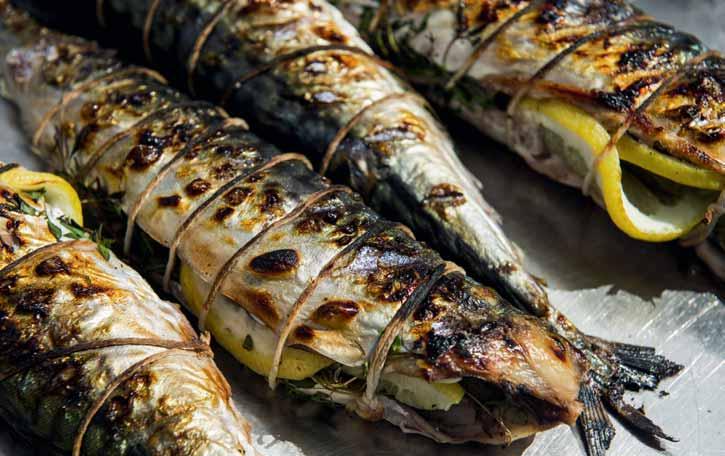
16 minute read
A decline in Norwegian consumption of seafood is being fought at several levels
by Eurofish
Putting fi sh back on the menu
Seafood is declining in popularity in Norway, a country with one of the world’s highest fi gures for per capita consumption. Falling interest in seafood is prompting the authorities and institutions to fi nd out the reasons behind this development and devise ways to counter it.
Advertisement
Norway is the world’s largest exporter of fi sh and seafood in terms of value after China. Th e country is however not only an impressive exporter but is also an avid consumer of fi sh and seafood products. Within Europe, it is only the Icelandics and the Portuguese who eat more seafood than the Norwegians. However, as in many countries, even those with a long tradition of eating seafood, consumption in Norway is declining. Seafood is associated with a number of health benefi ts both in children and adults. Falling fi sh consumption therefore can have repercussions on public health, so a number of initiatives backed by a network of public and private institutions have been put in place to reverse this trend.
Among these is the Norwegian Directorate of Health, a body with a mandate to improve the general level of health among Norwegians. A recent report from the directorate analyses developments in the Norwegian diet. What people eat is among the factors closely related to the risks of developing illnesses and of premature death and the directorate’s recommendations regarding diet, nutrition, and physical activity are intended to reduce these risks. Th e sustainability of a diet is also an aspect that is taken into consideration when making national recommendations today and a healthy diet, meaning one with a high content of fruit, vegetables, and whole grain products and a low content of red and processed meats, is generally more sustainable. Th e report fi nds that the development in Norwegian eating habits between 2008 and 2018 has been mixed. Sugar and milk consumption declined, that of vegetables increased, consumption of meat decreased slightly, while that of fi sh fell considerably. In 2018, Norwegians ate 2.6 times more meat than fi sh, a fi gure that was 2.2 in 2008.
Several factors behind the fall in seafood consumption
Th e decline in seafood consumption in Norway is well documented. Studies commissioned by the Norwegian Seafood Council, a body owned by the Ministry of Trade, Industry and Fisheries to promote Norwegian seafood to the world, show that consumption in Norway has declined across
40.00


Norwegian seafood consumption in terms of whole round weight
35.00
10.00 15.00 20.00 25.00 30.00 kg/captia/year



5.00
0.00
2003 2005 2007 2008 2009 2010 2011 2012 2013 2014 2015 2016 2017 2018 ՞



Source: Utviklingen i norsk kosthold 2019 *Provisional Andreas Lindlahr/Norwegian Seafood Council

According to a joint FAO WHO consultation, among the general adult population, consumption of fi sh, particularly fatty fi sh (such as the pictured mackerel), lowers the risk of mortality from coronary heart disease.
species i.e. volumes consumed of all the main species (salmon, cod, shrimp, mackerel, saithe, herring, and trout) have fallen consistently between 2013 and 2017. Annual seafood consumption has also dropped across all age groups except for the elderly. Th e latter not only eat the most seafood but have also maintained their consumption over the years even as other age groups have reduced theirs. A cause of much concern is that the reduction in consumption is most marked among people between 18 and 34 years of age. Research has shown that eating habits tend to settle from around 30 years and if eating fi sh and seafood is not a habit by then, it may never become one. Th is is also the time when people start to have children, and if the parents are unused to eating seafood themselves, it is unlikely they will inculcate a fi sh-eating habit in their off spring. Th e fear is that as the generation that eats the most fi sh (the elderly) gradually passes away, it will be replaced by another that is less interested in fi sh with potential consequences for public health as well as for the seafood industry. But why do young people turn away from fi sh? Th e reasons are manifold. Increasingly busy lifestyles mean less time to spend preparing meals. Fish is considered more diffi cult to cook than other forms of animal protein and it off ers less product variety compared, for example, with pork or chicken. Seafood is more expensive than meat and its price increased by 14 between 2013 and 2017, while food in general increased 8 over the same period. For some, fi sh is associated with negative experiences in childhood making them less inclined to eat it as adults. Some consumers surveyed implied that they did not eat fi sh for pleasure, but because it was healthful. Eating fi sh was akin to carrying out a duty — virtuous, but not enjoyable. Meat, on the other hand, they ate because they wanted to. A few consumers also stated that fi sh was diffi cult to fi nd in supermarkets in comparison to meat. A harried shopper could easily grab a packet of meat, pay, and leave, while fi nding the fi sh takes more time and eff ort.
Consumption of fi sh and seafood offers a range of benefi ts
documented in multiple studies. From infancy a diet rich in fi sh and seafood sets the stage for healthy development. Metabolic programming is the term used to describe the link between early diet and later health status, and studies have shown that the diet of expectant and nursing mothers as well as that of young children infl uences the risk of development of certain non-infectious diseases such as cardiovascular disease, hypertension, or type 2 diabetes later in the child’s life. Pregnant women can promote the development of their children and reduce the risk of the child contracting certain diseases as an adult by consuming a diet rich in fi sh and seafood while pregnant and during breast-feeding. In addition, such a diet is considered to have a positive impact
on a child’s health, neurological development, and the growth and function of the brain.
A European Food Safety Authority panel tasked with addressing the risks and benefi ts of fi sh and seafood consumption concluded that seafood is a source of energy and essential nutrients such as vitamins A and D, iodine, selenium, and calcium, all of which have well-established health benefi ts. Seafood also provides certain fats, the omega-3 fatty acids, that are also associated with good health. Compared with mothers who ate no seafood, consumption of about 1-2 servings of seafood per week and up to 3-4 servings per week during pregnancy led to better functional outcomes of neurodevelopment among infants measured in terms of communication and motor skills, and social and visual development. Th is level of consumption is also linked with a lower incidence of coronary heart disease among adults. Other studies have shown that fi sh consumption reduces the risk of mortality from cardiovascular disease as well as the risk of contracting diabetes.
Seafood is also an important source of other nutrients and bioactive components such as phospholipids, proteins and peptides, taurine, fi bre, and carotenoids among others. One carotenoid, ȕ-carotene, forms vitamin A in the human body, others have been seen to cause reductions in biomarkers of oxidative stress, infl ammation, and triglyceride levels and reduce the risk of stroke, and various cancers. High levels of fi bre are contained in edible seaweed and have been shown to reduce the risk of certain cancers and suppress gastrointestinal infl ammation. Polysaccharides extracted from various edible seaweeds have been seen to reduce cholesterol

and triglyceride levels in plasma in animal studies and they are also associated with anticoagulant, antiviral, and antioxidant activity. Taurine, an amino acid largely obtained through seafood, plays a role in several important biological processes in the human body, including calcium modulation, antioxidation, and immunity and may bring about a reduction in the risk of lifestylerelated diseases. Seafood is a very good source of protein that has excellent amino acid scores and digestibility. In addition, it may have a positive impact on lipid metabolism and on insulin sensitivity in insulin-resistant individuals. Other studies have suggested that dietary protein from fi sh off ers a signifi cant reduction in the risk of cardiovascular disease. Certain fi sh proteins are associated with reduced serum and liver cholesterol levels, and with the inhibition of fat absorption in the small intestine and thereby in suppressing an increase in body mass. Several human studies have shown that krill oil, which has phospholipid containing omega-3 fatty acids, cause desirable increases in plasma and cell membrane levels of omega-3 fatty acids. Th ese phospholipids can also alleviate obesity-related disorders, and act as anti-tumour, anti-infl ammatory, and antioxidating agents.
Collaboration necessary between all seafood industry players
Since seafood is closely associated with better health outcomes, there are sound reasons to encourage its consumption. A number of initiatives are proposed in the action plan to boost the presence of fi sh and seafood in Norwegian diets. Th ese include promoting the links between seafood and health, disseminating information about seafood, researching further into
seafood’s content of nutrients, directing advice on seafood to vulnerable social groups including children, young people, pregnant women, and certain immigrant populations, and increasing collaboration between the administration, the food industry, and other stakeholders to augment seafood consumption. Institutional measures also play a key role in boosting seafood consumption. Th e Norwegian national dietary action plan 2017-2021 is intended to contribute to diets that promote health and prevent diet-related illnesses in the population as a whole with emphasis on children and their families, young people, and the elderly. With regard to fi sh consumption the goal is to increase it by a fi fth by 2021 in the population as a whole and the same increase in the number of children and young people who eat fi sh at least once a week and a fi sh-based sandwich topping at least three times a week. Other goals include a reduction in the consumption of sweets, sugary drinks, saturated fats and salt, and an increase in vegetables, fruits, and whole grains. Currently roughly four tenths of men and three tenths of women eat the recommended quantity of fi sh, while only a quarter of men and a fi fth of women eat the recommended quantity of fatty fi sh.
Consumers latent desire to eat more seafood can be realised
Kantar, a market research organisation, has established that consumers desire to eat more fi sh, but fi nd translating this desire into reality a challenge. Th is fi nding suggests there is considerable potential to boost seafood consumption, which is something that the Norwegian Seafood Council and other organisations promoting fi sh consumption can build on. However, consumer

Salmon is the most popular fi sh to be eaten in Norway, where it is sold in different ways including as sashimi.
wishes regarding fi sh and seafood will have to be accommodated if consumption is to increase. Families with small children for example want meals that are quick to fi nd, buy, and prepare, and are inexpensive. People under 40 are looking for suggestions on how to prepare a meal that revolves around fi sh. Th ey are also looking for more convenience products that are quick and easy to prepare. Consumers are also infl uenced by the reputation of farmed fi sh. Salmon is the most consumed seafood in Norway, but among some consumers farmed salmon has a poor reputation. Th is is mainly due to a lack of knowledge, or because of the spread of rumours, myths, or fake facts. Working to disseminate factual information about salmon farming and the salmon industry that can counter the negative stories about the sector, may in the long term boost the consumption of salmon. According to the Norwegian Seafood Council, initiatives to boost the consumption of seafood should endeavour to increase consumers’ desire to eat more seafood and should make it easier to for them to choose seafood. Th e former can be achieved by focusing on attributes such as high quality, healthful, and sustainable, and by disabusing consumers of the idea that it is diffi cult to prepare or combine with other dishes.
Selecting seafood when at a supermarket can be stimulated, among other things by highlighting simple recipes, or off ering fi sh-based meals that are ready to cook or heat, or placing fi sh together with foodstuff s (vegetables, pasta etc.) that it can be eaten with.
Eating more seafood scores points for the environment too
Increasing fi sh consumption while reducing intake of red meat not only brings health benefi ts to the individual but also contributes to the health of the planet, an argument which may well resonate with the young. Findings of the EAT-Lancet Commission, a multinational group of scientists tasked with defi ning targets for healthy diets and sustainable food production, found that global food production is the single largest driver of environmental degradation. At the same time, unhealthy diets are the leading risk factor for non-communicable diseases the incidence of which is growing. “Eff ectively, how we grow, process, transport, consume and waste food is hurting both people and the planet”, assert the authors. While the positive infl uence of seafood consumption on human health is well documented, the discussion about its environmental impact is more recent. In a paper published in Frontiers in Ecology and the Environment in 2018, Ray Hilborn and colleagues showed how there were big diff erences in the environmental impact of fi sh production and consumption. Th e species of fi sh or seafood, whether it is farmed or wild, how it is farmed or caught, and how it is processed, stored, and transported
all determine a product’s impact on the planet. Comparing four metrics of environmental impact (greenhouse gas emissions, energy use, release of nutrients, and acidifying compounds) for livestock production, aquaculture, and capture fi sheries, as well as studying additional literature on antibiotic use, freshwater demand and pesticide use, the authors concluded that the lowest impact production methods were small pelagic fi sheries and mollusc aquaculture, whereas the highest impact production methods were beef production and catfi sh aquaculture.
Fish, white meat and vegetables can replace red meat
Substituting seafood for meat is thus likely to make sense from an environmental perspective depending on what the seafood is and how it is produced. But Nicole Darmon from INRA, the French National Institute for Agricultural Research, reported at a conference in Copenhagen in 2019 that reducing intake of meat, fi sh, poultry, and eggs, while increasing that of fruit and vegetables, could achieve a reduction in environmental impact of 30-40. Her fi ndings suggest there is a tradeoff between a diet that is healthful (thanks to the seafood) and one that is environmentally-friendly. Another paper by scientists from the Universities of Tasmania and of British Columbia published in the journal Nature Climate Change in 2018 estimates that carbon emissions from marine fi sheries, and small pelagic fi sheries in particular, are low compared with those from the production of red meat such as beef and lamb. More recently Greenpeace, an environmental NGO, in a criticism of the European Commission’s proposed European Green Deal said that climate and environmental targets could only be met “with a substantial reduction in the production and consumption of livestock products, particularly meat.” Th e Norwegian dietary action plan emphasises the importance of health as well as of sustainability when making food choices. With a point of departure in the Brundtland Report’s (named after Gro Harlem Brundtland, a former prime minister of Norway) defi nition of sustainable development (development that meets the needs of the present without compromising the ability of future generations to meet their own needs) the plan expects to contribute to sustainable development by encouraging people to make dietary choices that have a low impact on the environment. Th ese choices should also promote a reduction in food waste as this will increase the supply of food without adding to the pressure on the environment. At the end of 2016 the government presented a white paper to Parliament on the future of Norwegian agriculture which stated that a reduction in emissions from agriculture based on reduced demand for red meat would call for increased consumption of fi sh, as well as vegetables, and white meat.
Th e reduction in seafood consumption among Norwegians could, in the long term, have impacts on public health, the economy of the seafood sector, and potentially on the environment. By adopting a multipronged approach that draws on support from different stakeholders, authorities, institutions, trade bodies, research organisations etc., and that targets the general public with a special focus on certain groups, this negative trend can hopefully be reversed. A successful campaign will also have international repercussions as other countries facing similar challenges could learn from Norway’s experiences. Th e stakes are thus higher than they seem.
Fiskesprell, a programme to encourage youth to eat fi sh
Catch ‘em young
Started in 2007 as a consequence of a government action plan to improve the Norwegian diet, Fiskesprell is a programme aimed at increasing the consumption of fi sh and seafood among children and young people. The programme was so successful it was continued after the action plan concluded in 2011. Two ministries, the Norwegian Seafood Council, and the Norwegian fi sh sales organisations collaborate on Fiskesprell, and the Directorate of Health and the Marine Research Institute are both involved in designing the measures taken by the programme. Fiskesprell targets employees in kindergartens, schools, and in other institutions for children and young people, as well as teachers instructing in the subjects food and health. The programme organises courses for these target groups to increase their knowledge of seafood — including its health benefi ts and how to prepare it. Educating these groups about fi sh and seafood can have an impact on the diets of most children and young people in the country. Ultimately, the objectives of Fiskesprell are to get children and young people to eat more fi sh and seafood and reduce social disparities in diets and in this the initiative has succeeded. Assessments of the programme show that kindergartens that have been part of Fiskesprell show a higher consumption of fi sh and seafood and a greater awareness of healthful food. Support from Fiskesprell has led to a greater focus on seafood in the subject “food and health” among both teachers and pupils.
The Fiskesprell programme encourages children and young adults to eat more fish by making them aware of the health benefits and showing them how easily it can be prepared.











